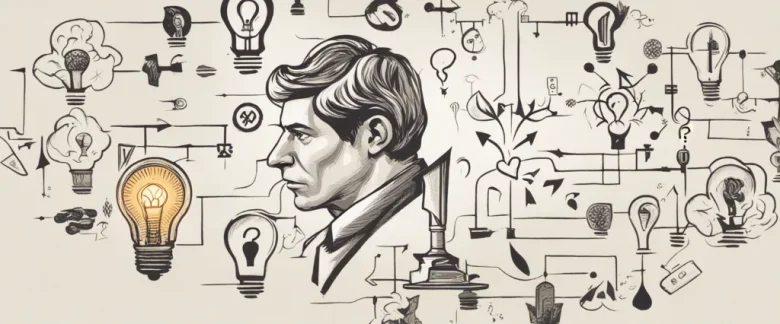
In the book “Competing Against Luck: The Story of Innovation and Customer Choice”, renowned business consultant and Harvard Business School professor Clayton M. Christensen explores a fundamental question: why do some products and services succeed while others fail? Christensen’s expertise lies in disruptive innovation, and in this thought-provoking book, he reveals a groundbreaking theory that explains the true origin of success in the marketplace. By shifting the focus from products and features to understanding what drives customer choice, the author offers valuable insights on how businesses can uncover hidden opportunities and effectively compete in an ever-changing landscape. Through compelling real-life examples, Christensen demonstrates the power of his theory, known as the “Jobs Theory,” offering readers a fresh perspective on innovation and successful business strategies.
Chapter 1: The Jobs Theory
In Chapter 1 of “Competing Against Luck” by Clayton M. Christensen, the author introduces the concept of the Jobs Theory, which aims to help businesses understand the true underlying reasons why customers choose specific products or services.
Christensen argues that traditional marketing methods often fail to provide a reliable understanding of consumer needs because they focus too much on demographics, purchasing behavior, and other external factors. Instead, the Jobs Theory proposes that people “hire” products or services to help them accomplish specific jobs in their lives. Understanding these jobs and the progress customers are trying to make in their lives is key to delivering successful and innovative solutions.
The author illustrates this theory using the example of a fast-food restaurant. Rather than focusing solely on the type of food people eat or their demographic information, Christensen emphasizes the importance of identifying the progress a customer wants to achieve when “hiring” a fast-food restaurant. This progress can include quickly satisfying hunger, enjoying a meal with friends, or finding a convenient food option while traveling.
By understanding these underlying jobs and the circumstances in which customers find themselves when they seek specific solutions, businesses can develop products and services that cater precisely to their needs. This Jobs Theory approach enables companies to disrupt existing markets by better addressing customers’ unmet needs.
Overall, Chapter 1 sets the foundation for the book and highlights the importance of looking beyond surface-level customer attributes to truly understand why customers “hire” certain products or services. Through the Jobs Theory, businesses can gain a deeper understanding of their customers’ needs and ultimately create products and experiences that fulfill them more effectively.
Chapter 2: Understanding Customer Needs
Chapter 2: Understanding Customer Needs of the book Competing Against Luck by Clayton M. Christensen explores the concept of the “job-to-be-done” theory. This theory suggests that customers do not simply purchase a product or service, but rather “hire” them to solve a specific problem or accomplish a particular task in their lives. By understanding the fundamental jobs that customers are trying to get done, companies can create products and services that truly meet their needs.
Christensen explains that customers often hire products based on their ability to make progress in a specific circumstance. Companies must dig deep to uncover the real motivations behind customers’ “hiring decisions.” Traditional market research and customer surveys often fall short in this aspect, as customers are unable to articulate these needs accurately. Instead, a more effective approach can be found by observing customers directly and identifying the underlying job they are trying to accomplish.
The author introduces the concept of the “circumstance” as a powerful driver in understanding customer needs. Each circumstance has three components: the job-to-be-done, the fundamental problem associated with it, and the desired outcome. These circumstances can be market-based, such as breakfast cereal solving the job of providing a convenient and enjoyable breakfast option, or life-based, like a person’s desire to have a healthier lifestyle.
To illustrate the importance of understanding customer needs, Christensen provides various examples, including the success of the McDonald’s milkshake. By meticulously observing customers, the company discovered that most milkshakes were being hired for a specific job – to provide a suitable breakfast option for busy commuters. This revelation led to the development of a thicker, morning-oriented milkshake that could be consumed while driving, satisfying the customers’ specific needs.
In summary, Chapter 2 emphasizes the need for companies to shift their focus from products or services to the jobs customers are trying to accomplish. By understanding customer needs, companies can create innovative solutions that succeed by addressing a specific problem, ultimately capturing greater market share.
Chapter 3: Progress and the Jobs Map
Chapter 3 of “Competing Against Luck” by Clayton M. Christensen focuses on the concept of progress and how it is connected to the development of a jobs map. The chapter explores how companies can better understand and meet customer needs by identifying the progress they are trying to make in their lives.
The chapter begins by explaining that customers “hire” products or services to help them make progress in several areas of their lives. Customers have a particular job to be done, and they look for solutions that can help them achieve their goals or overcome challenges. Christensen introduces the concept of a jobs map, which is a tool that helps companies understand their customers’ progress and design products or services that meet these needs effectively.
The key to creating a jobs map is identifying the customers’ struggle, which refers to the challenges they are facing in achieving their desired progress. By understanding these struggles, companies can innovate and develop solutions that specifically address the obstacles customers encounter. The author emphasizes that companies should focus on the job they are being hired for and not just the products or services they offer.
Furthermore, the chapter stresses that the jobs map should be dynamic and adaptable. As customer needs and circumstances change, the jobs map should be updated to reflect these shifts. Christensen provides examples of successful companies that have embraced the concept of the jobs map, such as Intuit, the maker of TurboTax, who realized that customers were struggling with the complexity of filing taxes and designed a simple and user-friendly solution to address this need.
In summary, Chapter 3 highlights the importance of understanding customer progress and developing a jobs map to meet their needs effectively. By focusing on the customers’ struggle and continuously updating the jobs map, companies can create products and services that help customers make the desired progress in their lives.
Chapter 4: The Value Proposition

In Chapter 4 of “Competing Against Luck” by Clayton M. Christensen, the focus is on understanding the importance of the value proposition in delivering a successful product or service to customers. The value proposition is the promise of value and utility that a company makes to its customers, highlighting how its offering stands out from the competition and meets customers’ needs.
Christensen explains that the value proposition should not be defined solely by a company’s description of its product or service features. Instead, it should be shaped by the job that customers are trying to get done. Understanding the job to be done is critical in identifying the value that a product or service brings to customers.
To illustrate this concept, Christensen uses the example of a fast food restaurant. While many people assume that customers choose a fast food restaurant based on the food or price, in reality, the jobs to be done are often related to convenience and speed. Customers are typically looking for a quick, hassle-free meal that allows them to continue with their busy schedules. By focusing on understanding and improving these aspects, fast food restaurants can deliver a stronger value proposition.
The chapter argues that companies often fail to deliver a compelling value proposition because they focus too much on the mechanics of the product or service and not enough on the job customers are trying to fulfill. Christensen emphasizes the importance of empathizing with customers and understanding the context and circumstances in which they are attempting to get the job done. Only by doing so can companies design a value proposition that truly satisfies customers and beats the competition.
Chapter 5: The Importance of Context
Chapter 5 of “Competing Against Luck” by Clayton M. Christensen delves into the concept of context and its crucial role in understanding and predicting customer behavior. The chapter highlights the flaws and limitations of traditional market research methods that often fail to gather insightful and actionable data on customer needs.
Christensen introduces the concept of the “Jobs to Be Done” theory, which argues that customers “hire” products or services to accomplish specific tasks or fulfill certain needs. However, the success of a product or service depends on the specific contextual circumstances in which customers are looking to get a job done. Understanding and analyzing these contextual details is essential for companies to develop innovative solutions.
The chapter offers numerous examples to illustrate the significance of context. It states that customers’ needs and preferences change depending on the situation, and therefore, a company should not focus solely on identifying an average customer. Instead, companies should aim to identify the circumstances in which customers are struggling or trying to achieve a particular outcome.
Through real-world cases, Christensen demonstrates how companies such as Target and Intuit have effectively leveraged contextual information. They have created innovative solutions by recognizing and addressing the specific circumstances in which customers struggle during their purchasing process, ultimately leading to successful product launches.
In summary, Chapter 5 emphasizes the importance of context in understanding customer behavior and making informed business decisions. By digging deeper into the various contexts in which customers operate, companies can discover unmet needs and develop products or services that truly address those needs. By doing so, companies can gain a competitive advantage and better serve their customers’ desires.
Chapter 6: Building a Customer-Centric Organization
Chapter 6: Building a Customer-Centric Organization of the book Competing Against Luck by Clayton M. Christensen focuses on the importance of creating a customer-centric organization to drive innovation and success in business.
The chapter begins with the recognition that companies often face difficulties in understanding their customers’ needs and desires. According to the authors, this is because most companies rely on demographic and psychographic profiling, which focuses on understanding broad customer segments, rather than gaining a deep understanding of what specific jobs customers are trying to accomplish in their lives. To truly build a customer-centric organization, companies need to focus on understanding the “jobs to be done” and how their product or service fits into those jobs.
Christensen and his co-authors introduce the idea of a “Job Architect” as a role within the company whose responsibility is to deeply understand customers’ jobs and develop strategies around them. The Job Architect can act as the voice of the customer within the organization, driving customer-focused decision-making and innovation.
The authors also emphasize the importance of utilizing a systematic approach to understanding customer jobs and measuring success. They propose using the “Mom Test” as a way to assess whether a company truly understands its customer’s job and if its product or service is making meaningful progress. The Mom Test requires asking external customers if they would recommend the product or service to their own mother, as a measure of the offering’s value.
In order to build a customer-centric organization, the authors highlight the importance of developing empathy within the organization and embracing a learning mindset. By continually seeking feedback from customers and integrating it into their decision-making processes, companies can create a sustainable competitive advantage and ultimately deliver products and services that better serve their customers’ needs.
In summary, Chapter 6 of Competing Against Luck emphasizes that understanding customers’ jobs to be done is crucial for building a customer-centric organization. By nurturing a deep understanding of customer needs and integrating it into decision-making, companies can drive innovation and outperform their competitors in meeting customer demands.
Chapter 7: Innovating for Jobs to Be Done
Chapter 7 of “Competing Against Luck” by Clayton M. Christensen titled “Innovating for Jobs to Be Done” emphasizes the importance of understanding the “jobs” that customers are trying to get done. This involves identifying the underlying problems that customers are trying to solve and developing products or services that truly address those needs.
The chapter begins by explaining that customers hire products or services to help them accomplish a particular “job.” This job can range from simple tasks to complex problems. For instance, a customer hiring a coffee shop may simply want a hot cup of coffee in the morning to help wake up and start the day.
Companies often fail to understand the job their customers are hiring their products for, leading to unsuccessful innovations. It is essential to go beyond demographics and ask the right questions to unveil the underlying job customers are hiring a product to do. The chapter illustrates the concept with the example of fast-food chain McDonald’s. When McDonald’s entered the breakfast market, their competitors failed to understand the job customers were hiring a breakfast sandwich for: a quick, easy and inexpensive meal on the go. McDonald’s succeeded in serving this job more effectively than their rivals by offering a portable and affordable Egg McMuffin.
Christensen introduces a Job to Be Done framework to guide companies in identifying and addressing customers’ jobs more effectively. This framework involves understanding the specific functional, emotional, and social dimensions of a job and developing products or services that satisfy those aspects. Through this framework, businesses can uncover unrealized customer needs and create innovations that exceed customer expectations.
Overall, Chapter 7 underscores the significance of understanding the jobs customers are hiring products for, providing companies with the insights necessary to develop successful innovations and better serve their customers’ needs.

Chapter 8: Creating Lasting Competitive Advantage
Chapter 8 of “Competing Against Luck” by Clayton M. Christensen focuses on strategies businesses can employ to create lasting competitive advantage. The chapter emphasizes that understanding the jobs customers are trying to get done is critical in sustaining a competitive edge.
Christensen introduces four elements that contribute to creating a sustainable advantage: customer lock-in, economies of scale, barriers to entry, and network effects. However, he argues that none of these elements are inherently sustainable and can be disrupted over time.
To counteract this, businesses must focus on understanding the customers’ circumstances, needs, and the progress they are trying to achieve. Christensen introduces the concept of “Job to Be Done” (JTBD), where customers “hire” products or services to get a specific job done. By gathering deep insights into the JTBD, companies can create superior offerings that meet customers’ needs better than their competitors’.
The innovation process plays a crucial role in creating lasting competitive advantage. Christensen outlines four steps to achieving this: assembling a dedicated team, mapping customers’ JTBD, identifying associated metrics, and conducting controlled experiments to test various solutions.
Furthermore, Christensen highlights the importance of learning from unsuccessful attempts and iterating on the innovation process. By embracing a mindset of continuous improvement and incorporating customer feedback, businesses can fuel ongoing innovation and sustain their competitive advantage.
In summary, Chapter 8 emphasizes the need to understand customers’ jobs to be done, leverage innovation, and continuously improve offerings to create lasting competitive advantage. By continuously aligning products and services with customers’ evolving needs, companies can position themselves as true market leaders.
After Reading
In conclusion, “Competing Against Luck” by Clayton M. Christensen takes a deep dive into the theory of Jobs to be Done (JTBD) and explores how companies can truly understand and cater to the needs of their customers. The book emphasizes the importance of looking beyond traditional demographic and psychographic data, and instead focuses on the progress a customer is trying to achieve in a particular circumstance. By identifying the specific Job to be Done, companies can innovate and create products and services that address customers’ unmet needs more effectively. Through insightful case studies and analysis, Christensen demonstrates that true innovation lies in understanding the customers’ Jobs to be Done and building businesses that compete against luck by consistently delivering on those needs. Overall, “Competing Against Luck” offers valuable insights and practical strategies for companies to succeed in today’s increasingly competitive market.
1. The Road Less Traveled” by M. Scott Peck
This book delves into the journey of personal growth and self-discovery. Peck explores the importance of embracing challenges, taking responsibility for our actions, and developing spiritual and emotional resilience. It offers valuable insights on enhancing relationships, living a fulfilling life, and finding true happiness.
2. Sapiens: A Brief History of Humankind” by Yuval Noah Harari
In this thought-provoking book, Harari takes readers on an intellectual adventure through the history of Homo sapiens, from the emergence of our species to the present day. He explores major turning points, such as the agricultural revolution and the scientific advancements that shaped our society. It challenges our understanding of humanity and offers a unique perspective on our collective story.
3. Educated” by Tara Westover
A gripping memoir, “Educated” recounts Tara Westover’s remarkable journey from growing up in a strict, isolated family in rural Idaho, to eventually obtaining a PhD from Cambridge University. It is a powerful exploration of the transformative power of education, resilience, and the pursuit of knowledge against all odds.
4. Becoming” by Michelle Obama
Through her candid and inspiring memoir, former First Lady Michelle Obama shares her personal and professional journey, from growing up on the South Side of Chicago to her experiences in the White House. It offers a glimpse into her life, challenges faced, and the values that drove her during her time in the public eye. “Becoming” is a story of resilience, authenticity, and the power of hope.
5. The Power of Now” by Eckhart Tolle
A spiritual classic, “The Power of Now” guides readers on a transformative journey toward living in the present moment. Tolle explores how transcending our ego-based thinking can alleviate suffering, enhance self-awareness, and lead to a deeper sense of peace and fulfillment. It offers practical tools for experiencing a greater level of consciousness and finding joy in daily life.



